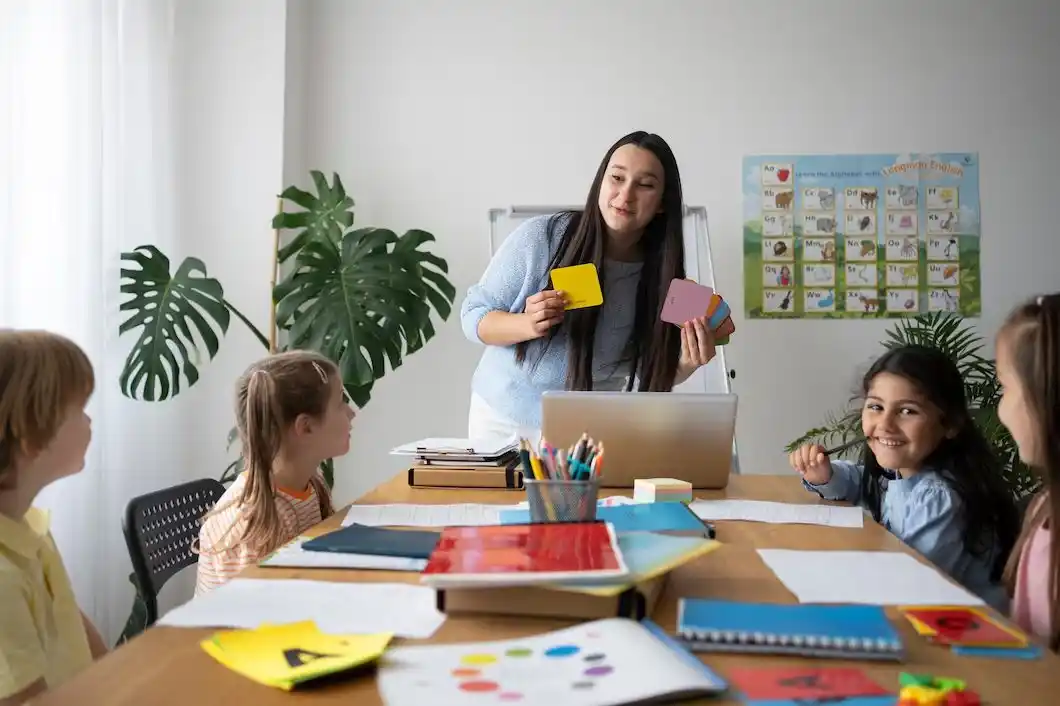The Education Blog

How to Help Your Child Develop a Love for Learning
All parents want their children to excel, but academic success is more than just about grades—it’s about nurturing a lifelong love of learning. A mix of intrinsic curiosity and passion causes children to become independent thinkers and problem solvers at a very young age. However, many parents find it difficult enough to keep their children engaged, especially in a time of digital distraction.
If you’re wondering how to help your child learn, maintain interest in education, and develop self-motivation, this guide provides actionable strategies that promote learning motivation and a positive attitude towards education for kids.
Looking for ways to improve your memory? Look no further!
1. Foster a Growth Mindset
Adopting a growth mindset helps you embrace challenges, learn from failures, and continuously improve. It encourages resilience, adaptability, and a willingness to develop new skills, leading to personal and professional success.
Encourage Effort Over Results
Children often feel discouraged when they struggle with a subject or task. You teach them that learning is a process by praising the efforts rather than just results. Instead of saying, “You’re so smart!” try saying, “I love how hard you worked on this!” This reinforces perseverance and resilience.
Teach That Mistakes Are Part of Learning
Many children fear making mistakes, which can hinder their willingness to try new things. Help your child see errors as opportunities for growth. Ask them, “What did you learn from this?” or “How can we approach it differently next time?” This encourages problem-solving and reduces frustration with challenges.
Model a Growth Mindset
Children learn by observing their parents and teachers. If they see you approach challenges with curiosity rather than frustration, they will mirror that attitude. Express excitement when learning something new and share your own struggles and triumphs with them.
2. Make Learning Fun and Engaging

Learning becomes more effective when it’s enjoyable and interactive. Incorporate games, hands-on activities, and real-world applications to keep yourself engaged and motivated throughout the process.
Use Play-Based Learning
Play is how children learn instinctively. For example, if they spend their days enriching themselves mind-wise, include educational games, puzzles, and role-playing in their daily activities. Math and vocabulary board games enhance cognitive skills. Plus, they make learning fun!
Leverage Technology Wisely
Screen time in excess is not good for you. Educational apps and interactive platforms, for instance, can serve as great learning tools. Educational apps such as ABCmouse, Duolingo for Kids and Kahoot! make learning interesting. It contains entertaining content that makes kids understand the topics better. Parental involvement in selecting and monitoring educational apps ensures children use them effectively.
Create Hands-On Learning Experiences
Experiential learning is more effective than passive memorisation. Do science experiments at home. Cook together to learn measurements. Take nature walks to see biology in action. Real-world applications make learning more tangible and meaningful.
3. Encourage a Reading Habit
Developing a strong reading habit enhances knowledge, critical thinking, and vocabulary. Set aside dedicated time each day to read books, articles, or research materials that align with your interests and goals.
Build a Home Library
Having a variety of books at home encourages children to read for pleasure. Pick books that match their age and interests. This could be adventure tales, science fiction, or illustrated encyclopedias. Books with diverse characters and themes help broaden their understanding of the world.
Read Together Regularly
Reading aloud, even to older children, enhances comprehension and vocabulary. Talk about the story. Ask questions like, “What do you think happens next?” Also, connect it to real-life experiences. Encouraging your child to retell stories in their own words strengthens their understanding.
Let Them Choose Books
Giving children autonomy in selecting books increases their motivation to read. Comics, graphic novels, and classic literature all spark a love for stories. Personal choice helps us explore and enjoy new ideas. Visiting the library together regularly introduces them to a broader range of reading materials.
4. Create a Positive Learning Environment

A positive learning environment fosters focus, motivation, and productivity. Ensure a well-lit, organized space free from distractions, and encourage curiosity and open discussions to make learning enjoyable.
Designate a Learning Space
A dedicated, clutter-free study area helps children focus. Ensure it is well-lit, stocked with necessary supplies, and free from distractions like TV and mobile devices. Personalising the space with inspiring quotes or artwork can make learning more inviting.
Establish a Routine
Consistency fosters discipline. Schedule specific times for reading, homework, and creative activities. This will help you build a regular learning routine. However, allow for flexibility to accommodate your child’s energy levels and moods. Making learning part of the daily routine normalises it as a natural and enjoyable activity.
Be a Learning Role Model
Children imitate their parents. Show enthusiasm for learning by reading books, engaging in discussions, or exploring new hobbies. Expressing curiosity about the world encourages them to do the same. Talking about fun facts or historical events in conversations helps us learn daily.
5. Connect Learning to Real Life
Relating learning to real-life experiences makes it more meaningful and memorable. Use practical examples, hands-on activities, and real-world applications to help reinforce concepts and keep learners engaged.
Relate Subjects to Everyday Activities
Math isn’t just about numbers on a worksheet—it’s in budgeting, cooking, and shopping. Science is in the kitchen when baking or outdoors when observing plants and animals. Showing how school subjects apply to daily life makes them more relevant and interesting.
Take Educational Trips
Museums, science centres, zoos, and cultural sites offer fun, hands-on learning outside the classroom. These experiences stimulate curiosity and reinforce academic concepts in a fun way. Visiting a farmer’s market can teach kids about economics, nutrition, and sustainability. Even simple activities like this offer valuable lessons.
Encourage Curiosity and Questions
If your child asks a question, take the time to explore the answer together. Use phrases like “Let’s find out!” or “That’s a great question—let’s research it together!” Encouraging inquiry builds critical thinking skills and a passion for discovery. Asking open-ended questions promotes deeper thinking.
6. Support Emotional and Social Learning
Emotional and social learning helps build confidence, resilience, and strong interpersonal skills. Encourage open communication, teamwork, and self-awareness to create a well-rounded and supportive learning experience.
Teach Emotional Intelligence
Understanding emotions and managing frustration are key components of learning. Help your child share their feelings about schoolwork. Also, support them in finding ways to cope with challenges. Teaching them deep breathing techniques or positive self-talk helps them manage frustration.
Encourage Collaborative Learning
Group activities, team projects, and study sessions with friends boost engagement and make learning more fun. Collaboration teaches valuable skills like communication, patience, and problem-solving. Role-playing historical events or conducting science experiments as a group enhances social learning.
Instill Resilience and a Positive Attitude
Help your child develop a mindset that embraces challenges rather than fears them. Stories of famous individuals who overcame failures can be inspiring. Reinforce that persistence and effort lead to growth. Encourage them to set small, achievable learning goals to build confidence.
7. Personalise the Learning Experience

Tailoring education to individual needs boosts engagement and comprehension. Use different teaching methods, adapt to learning styles, and provide flexible resources to create a more effective learning journey.
Cater to Their Learning Style
Children learn in different ways—some are visual learners, others are auditory or kinesthetic. Identify your child’s preferred learning style and adapt study methods accordingly. For example:
- Visual learners benefit from charts, diagrams, and videos.
- Auditory learners absorb information better through discussions and storytelling.
- Kinesthetic learners enjoy hands-on activities and interactive exercises.
Adapt to Their Interests
If your child is obsessed with space, you can add astronomy to their reading and science times. If they like music, use songs to teach math or language concepts. “When you add love to the learning, they are more distracted by love than what interests them.
Offer Choices in Learning Activities
Allowing kids to choose tasks like writing a report, making a presentation, or creating a model helps them feel in charge of their learning.
Nurturing a Lifelong Love for Learning: Encouraging Curiosity and Growth
Supporting children’s passion for learning goes beyond grades. It fosters curiosity, problem-solving skills and personal growth for life. To lay the groundwork for a strong curiosity in childhood, parents can create a positive experience in their own learning environment. Fun activities and an emphasis on effort rather than results should be used. This method allows children to investigate their surroundings and make sense of the world.
When children view learning as an expedition, they are motivated independently. It also helps them be more resilient. Those are life skills for them. But with some patience and proactive support, you can help your child take joy in learning. Motivate them to turn confident and excited.









